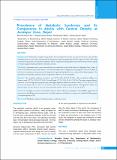Please use this identifier to cite or link to this item:
https://hdl.handle.net/20.500.14356/1496Full metadata record
| DC Field | Value | Language |
|---|---|---|
| dc.contributor.author | Jha, Birendra Kumar | - |
| dc.contributor.author | Sherpa, Mingma Lhamu | - |
| dc.contributor.author | Dahal, Binod Kumar | - |
| dc.contributor.author | Singh, Jitendra Kumar | - |
| dc.date.accessioned | 2023-05-14T09:33:59Z | - |
| dc.date.available | 2023-05-14T09:33:59Z | - |
| dc.date.issued | 2020 | - |
| dc.identifier.citation | JhaB. K., SherpaM. L., DahalB. K., & SinghJ. K. (2021). Prevalence of Metabolic Syndrome and Its Components in Adults with Central Obesity at Janakpur Zone, Nepal. Journal of Nepal Health Research Council, 18(4), 681-685. https://doi.org/10.33314/jnhrc.v18i4.2890 | en_US |
| dc.identifier.issn | Print ISSN: 1727-5482; Online ISSN: 1999-6217 | - |
| dc.identifier.uri | http://103.69.126.140:8080/handle/20.500.14356/1496 | - |
| dc.description | Original Article | en_US |
| dc.description.abstract | Abstract Background: Urbanization, surplus energy uptake, decreased physical activities are general risk factors of metabolic syndrome However, it’s status, and associated components remain unexplored in the Terai region of Nepal. This study evaluated the prevalence of metabolic syndrome and its components among adults with central obesity of Terai region of Nepal using International Diabetes Federation criteria. Methods: Community based cross-sectional study was conducted in three Terai districts of Janakpur Zone, Nepal. A total of 378 adults having central obesity were selected using cluster sampling by camp approach. Interview, physical and clinical examination, measurement of fasting blood sugar, and lipid profile were conducted for all participants. The prevalence of metabolic syndrome and its components with 95% CI were estimated. Results: The metabolic syndrome prevalence was 74.9% (95% CI:70.2-79.2%), with no significant differences between male (77.7%, 95% CI:71.0-83.5%) and female (72.2%, 95% CI: 65.2-78.3%). The most common factors observed were low high density lipoproteins with highly significant differences between male (77.7%, 95% CI:71.0-83.5%)) and female (90.2%, 95% CI: 85.094.0%-; p=0.001) and hypertriglyceridemia with significant differences between male (57.6%, 95% CI: 50.1-64.5%) and female (46.9%, 95% CI: 39.7-54.2%; p=0.037). Conclusions: Higher prevalence of metabolic syndrome and its risk factors in Janakpur of Nepal likely suggest lack of awareness and health promotion activities for metabolic syndrome and indicate an urgency for a public health program to maintain quality of life. Keywords: Metabolic syndrome; Nepal; prevalence; risk factors; terai | en_US |
| dc.language.iso | en | en_US |
| dc.publisher | Nepal Health Research Council | en_US |
| dc.relation.ispartofseries | Oct-Dec, 2020;2890 | - |
| dc.subject | Metabolic syndrome | en_US |
| dc.subject | Nepal | en_US |
| dc.subject | Prevalence | en_US |
| dc.subject | Risk factors | en_US |
| dc.subject | Terai | en_US |
| dc.title | Prevalence of Metabolic Syndrome and Its Components in Adults with Central Obesity at Janakpur Zone, Nepal | en_US |
| dc.type | Journal Article | en_US |
| local.journal.category | Original Article | - |
| Appears in Collections: | Vol. 18 No. 4 (2020): Vol. 18 No. 4 Issue 49 Oct-Dec 2020 | |
Files in This Item:
| File | Description | Size | Format | |
|---|---|---|---|---|
| 2890-Manuscript-20000-1-10-20210122.pdf | Fulltext Download | 240.1 kB | Adobe PDF |  View/Open |
Items in DSpace are protected by copyright, with all rights reserved, unless otherwise indicated.
